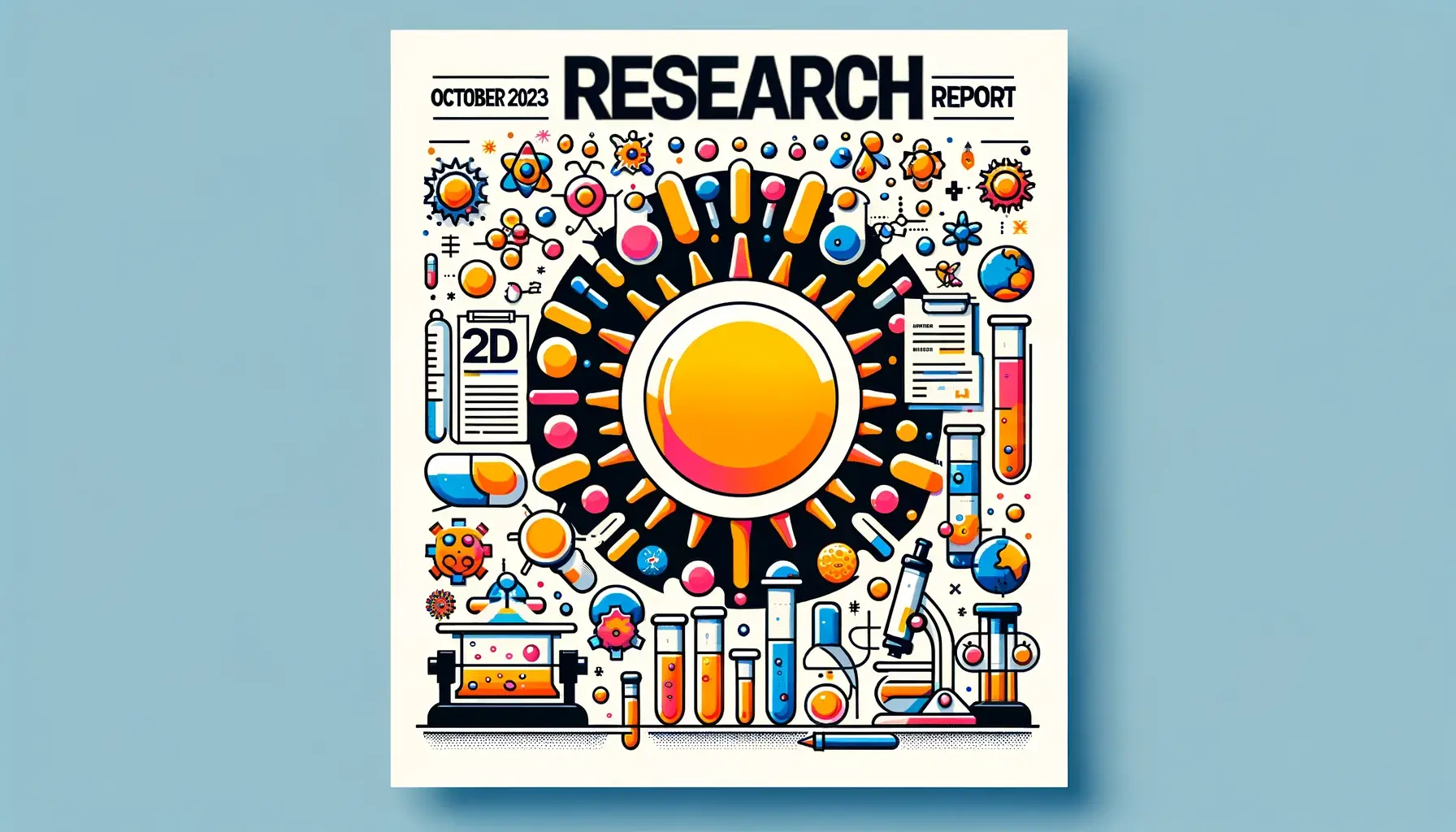Vitamin D Research: Top 5 Discoveries in October 2023

Vitamin D is widely known for its role in maintaining mineral homeostasis and regulating various physiological functions. Recent research has highlighted its potential effects on different health areas such as cardiovascular and neurodegenerative disorders, type 1 diabetes, and even osteomalacia and cancer. This blog post outlines five unique topics, based on recent abstracts, about the fascinating and potentially beneficial effects of Vitamin D.
1. Glucose Metabolism
Shao et al's research reveals the connection between Vitamin D metabolism and blood sugar levels. It indicates that the interruption of Vitamin D metabolism can cause hyperglycemia and regulates glucose metabolism by maintaining intestinal homeostasis.
Vitamin D Regulates Blood Sugar Levels [1]
By exploring the relationship between Vitamin D (VD) and glucose metabolism, we discovered important insights. Wheat we understood is that VD plays a crucial role in maintaining mineral homeostasis and regulating a variety of bodily functions. Interestingly, it was found that interrupting VD metabolism led to a spike in blood sugar levels in zebrafish. This points to the influence of Vitamin D on glucose metabolism by safeguarding intestinal homeostasis. The investigation showed that a lack of Vitamin D in diet caused a decrease in several peptide hormones in the intestine and an increase in glucose transporter expression. This interfered with sugar absorption in fish, giving us insights into the broader implications of VD-deficiency.
A unique aspect of this investigation was that it used germ-free zebrafish, which highlighted that VD-regulated glucose metabolism was partly dependent on gut microbiota. This was further validated by transplanting gut microbiota from a zebrafish whose endogenous VD metabolism was blocked to a germ-free fish. This led to high blood sugar symptoms in the fish, showing the alteration of the microbiota structure and functions without VD.
The treatment of hyperglycemic zebrafish, using acetate, gave promising results. Acetate, an active component produced by Cetobacterium somerae (a resident gut bacteria), helped lower glucose content and increased insulin expression in zebrafish. Notably, the acetate enhanced the effects of VD in maintaining glucose levels, proving useful in managing hyperglycemia.
In summary, the research reveals that Vitamin D's role extends beyond bone health. It also plays an essential part in glucose metabolism, gut microbiota, and gastrointestinal hormone axis. The study suggests the potential of using Vitamin D and acetate in managing blood sugar levels, expanding our understanding of its importance in overall health.
2. Bone Health and Diabetes
Oza et al's study focuses on the utility of BX (BoneXpert) in assessing bone health in Indian children and youth with Type-1 Diabetes. It demonstrates the positive correlation between Vitamin D concentrations and bone mineral density, essential for understanding how Vitamin D can help combat bone health issues in these individuals.
Boosting Bone Health in Type-1 Diabetic Youth with Vitamin D [2]
Here's some cutting-edge research about boosting bone health in children and youth with type-1 diabetes, primarily using a tool known as BoneXpert. This digital technology helps with assessments of bone age and the metacarpal index, important factors in measuring overall bone health. In a comprehensive study involving 1,272 subjects, this technology was utilized to analyze left-hand X-rays retrospectively. Additional data inputs included information about subjects' physical attributes, diet, clinical data, and crucially, their vitamin D concentrations.
It was found that BoneXpert could accurately measure the bone age in the subjects, with error margins of just 0.72 years and 0.67 years respectively as compared to traditional methods. On top of that, results from the metacarpal index generated by BoneXpert accurately echoed measurements of the bone mineral density and cortical density derived from more complex procedures. A significant finding was the positive correlation between vitamin D concentrations and the metacarpal index, suggesting that higher vitamin D levels can potentially promote better bone health.
On the other hand, high HbA1c levels and longer disease duration were negatively correlated with the metacarpal index, suggesting overall structural compromises in the bone. Despite these worrying findings, the silver lining here is the role of vitamin D. Not only is it a nutrient universally acknowledged for promoting bone health, but it also shows great promise in specifically bolstering bone health among children and youth grappling with type-1 diabetes.
3. Poultry Behaviour
Research by Ogbonna et al demonstrates the intriguing impact of Vitamin D provision via diet or ultraviolet-B light on the behaviour of broiler chickens. Further research could potentially benefit the behaviour and welfare of broilers.
UVB Light Exposure Effects on Broiler’s Natural Behavior and Vitamin D3 Level [3]
In an intriguing study, researchers delved into the relationship between Vitamin D, UVB light exposure and the behavior of broiler chickens. Broilers, which are chickens bred and raised specifically for meat production, typically live in indoor environments with little exposure to natural light, in turn affecting their natural behaviour. This study compared the effects of dietary Vitamin D3 supplementation with exposure to UVB light on broilers' behavior under stress. Specifically, the broilers were challenged with episodes of social isolation stress. Interestingly it was found that when broilers were exposed to UVB light, they exhibited more natural behavior compared to those given a Vitamin D supplement. They spent more time sitting inactive and sleeping, a behavior considered normal in chickens, when subjected to UVB light compared to those who weren’t. The study also found that chickens exposed to UVB light showed a decline in sunbathing activity under stress, compared to those that were not isolated. However, whilst UVB exposure appeared to promote natural behaviours, no large difference was noted in the behaviours of chickens simply provided with Vitamin D3 through their diet. This research is nonetheless a significant step forward in understanding the importance of UVB light and Vitamin D3 supplementation in poultry, considering that high stress levels can undermine overall poultry health and directly impact meat yield. The findings underscore the need for further research in investigating optimal light conditions for supporting natural behavior and welfare in poultry.
4. Parkinson's Disease
Džoljić et al's study underlines the significant relationship between hypovitaminosis D (vitamin D deficiency) and Parkinson’s Disease (PD). The research discloses higher occurrence of vitamin D deficiency in PD patients and its potential as a predictive factor for the onset and progression of PD.
Vitamin D Deficiency Correlates with Parkinson's Disease Progression [4]
A recent study delved into the connection between Vitamin D—a steroid hormone—and neurodegenerative disorders like Parkinson’s disease (PD). The aim of this research was to bring clarity to the correlation between lack of Vitamin D (hypovitaminosis D) and susceptibility to PD. The study also looked into the specific gene polymorphisms related to Vitamin D levels.
Participants for this study were both PD patients and controls (those without PD). Their serum was tested using a commercial immunoassay for total levels of 25(OH)-vitamin D (25(OH)D), the common indicator of Vitamin D in the body. Genetic analyses were done using Taqman assays on Real Time PCR amplification system. The researchers found a higher occurrence of Vitamin D deficiency among people with PD than in the controls. In fact, having low levels of Vitamin D appeared to be a predictive sign of PD. The study showed that patients with low Vitamin D had significantly higher scores on tests (UPDRS and HY scores), which quantify the severity of PD symptoms.
Although there were some observable trends, there wasn’t a significant difference in the distribution of alleles and genotypes between the PD patients and controls, or between different subgroups of these participants. Nevertheless, the research affirms the hypothesis of a substantial relationship between hypovitaminosis D and Parkinson’s disease. It demonstrated an increased prevalence of Vitamin D deficiency in PD patients and indicated that this deficiency could signal the onset and progression of PD.
This study is a step forward in understanding how Vitamin D levels could affect neurodegenerative disorders. Vitamin D's potential as a predictive factor for Parkinson's disease provides valuable insight that could be used for proactive measures in the future. It also opens doors for further research into how increasing Vitamin D levels could potentially slow the progression of PD.
5. Hypophosphatasia Regulation
The study conducted by Kamińska et al presents fascinating insights into how Vitamin D3 and insulin could potentially be regulating biological processes in the porcine ovarian follicles. Despite being specific to pigs, this research could provide valuable insights into potential treatment paths for hypophosphatasia in humans.
Vitamin D3 and Insulin Might Regulate Biological Processes in Ovarian Follicles [5]
The study by Kamińska et al provides captivating insights into the role of Vitamin D3 and insulin in potentially regulating biological processes within porcine ovarian follicles. Even though this study heavily focuses on pigs, the revelations could still turn out to be a game changer in offering potential pathways for treating hypophosphatasia in humans. Excitingly, the study sought to analyze the changes in cellular composition of granulosa and theca interna cells of porcine ovarian follicles after they were treated with vitamin D3 and insulin, either singly or in combination.
The study used various scientific methodology, including FTIR spectroscopy and histological staining to take a look at the effects. One striking finding was that when vitamin D3 and insulin were jointly administered, changes occurred in the content of fibrous proteins, especially collagens, within theca interna. Moreover, the secondary structure of proteins was also affected, indicating an enhanced conversion to α-helices due to the action/interaction of vitamin D3 and insulin within both follicular compartments.
The study also noted a tendency to lower DNA content in the group that was given both vitamin D3 and insulin, attesting to their potential role in affecting cellular composition. An intriguing alteration was also noticed in monosaccharide production in both follicular layers. As such, based on the scientific evidence from this study, the researchers have linked these observed alterations to biological processes that might well be regulated by vitamin D3 and insulin within porcine ovarian follicles.
The undeniable potential of vitamin D and insulin to be able to significantly impact how our bodies work and potentially alleviate diseases like hypophosphatasia gives us all hope for a brighter future. Going forward, this opens up new avenues for further research into the potent benefits of these substances.
Conclusion
The global research on Vitamin D is increasingly demonstrating its potential health benefits beyond bone health. From regulating glucose metabolism and maintaining bone health in diabetic patients, to influencing the behaviour of broiler chickens, lowering the risk for Parkinson's Disease, and even managing hypophosphatasia, Vitamin D's role in health is significantly diverse and potent. More research is necessary to fully understand these benefits and how best to incorporate Vitamin D supplementation into routine healthcare.
References
Shao, R., Liao, X., Wang, W., Lan, Y., Zhang, H., Du, Q., Jiao, L., Yin, Z., Ai, Q., Mai, K., & Wan, M. (2024). Vitamin D regulates glucose metabolism in zebrafish (Danio rerio) by maintaining intestinal homeostasis. The Journal of Nutritional Biochemistry, 123, 109473. https://doi.org/https://doi.org/10.1016/j.jnutbio.2023.109473
Oza, C., Khadilkar, A., Goel, P., Karguppikar, M., Shah, N., Lohiya, N., Mondkar, S., Patil, P., Prasad, H., Maheshwari, A., Ladkat, D., Kajale, N., More, C., Khurjekar, D., & Khadilkar, V. (2024). Utility of BoneXpert in assessing bone age and bone health in Indian children and youth with type 1 diabetes mellitus. Bone, 178, 116952. https://doi.org/https://doi.org/10.1016/j.bone.2023.116952
Ogbonna, A. C., Chaudhry, A. S., & Asher, L. (2023). Effect of dietary vitamin D3 and ultraviolet-B light on the behaviour and growth of broilers challenged with social isolation stress. Applied Animal Behaviour Science, 268, 106083. https://doi.org/https://doi.org/10.1016/j.applanim.2023.106083
Džoljić, E., Matutinović, M. S., Stojković, O., Veličković, J., Milinković, N., Kostić, V., & Ignjatović, S. (2023). Vitamin D Serum Levels and Vitamin D Receptor Genotype in Patients with Parkinson’s Disease. Neuroscience, 533, 53–62. https://doi.org/https://doi.org/10.1016/j.neuroscience.2023.10.004
Kamińska, K., Wiercigroch, E., Małek, K., & Grzesiak, M. (2023). Biomolecular composition of porcine ovarian follicles following in vitro treatment of vitamin D3 and insulin alone or in combination. Reproductive Biology, 23(4), 100818. https://doi.org/https://doi.org/10.1016/j.repbio.2023.100818
